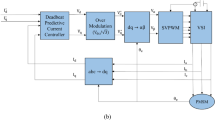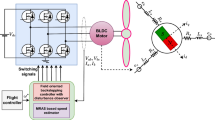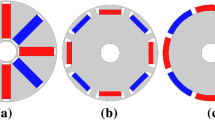Abstract
Because a V-belt continuously variable transmission system driven by Permanent magnet synchronous motor (PMSM) has many nonlinear and time-varying characteristics, the linear control design with better control performance has to execute a complex and time consuming procedure. To reduce this difficulty and raise robustness of system under the occurrence of the uncertainties, a hybrid recurrent Laguerre-orthogonal-polynomial Neural network (NN) control system which has online learning ability to respond to the system’s nonlinear and time-varying behavior is proposed in this study. This control system consists of an inspector control system, a recurrent Laguerre- orthogonal-polynomial NN control with adaptive law and a recouped control with estimated law. Moreover, the adaptive law of online parameter in the recurrent Laguerre-orthogonal-polynomial NN is derived using Lyapunov stability theorem. Two optimal learning rates of the parameters based on modified Particle swarm optimization (PSO) are proposed to achieve fast convergence. Finally, to verify the effectiveness of the proposed control scheme, comparative studies are demonstrated by experimental results.
Similar content being viewed by others
Change history
16 January 2021
An Erratum to this paper has been published: https://doi.org/10.1007/s12206-020-1243-8
References
C. Y. Tseng, L. W. Chen, Y. T. Lin and J. Y. Li, A hybrid dynamic simulation model for urban scooters with a mechanical-type CVT, IEEE International Conference on Automation and Logistics, Qingdao, China (2008) 519–519.
C. Y. Tseng, Y. F. Lue, Y. T. Lin, J. C. Siao, C. H. Tsai and L. M. Fu, Dynamic simulation model for hybrid electric scooters, IEEE International Symposium on Industrial Electronics, Seoul, Korea (2009) 1464–1469.
L. Guzzella and A. M. Schmid, Feedback linearization of spark-ignition engines with continuously variable transmissions, IEEE Transactions on Control Systems Technology, 3 (1) (1995) 54–58.
W. Kim and G. Vachtsevanos, Fuzzy logic ratio control for a CVT hydraulic module, Proc. of the IEEE Symposium on Intelligent Control, Rio, Greece (2000) 151–156.
G. Carbone, L. Mangialardi, B. Bonsen, C. Tursi and P. A. Veenhuizen, CVT dynamics: Theory and experiments, Mechanism and Machine Theory, 42 (4) (2007) 409–428.
H. Sattler, Efficiency of metal chain and V-belt CVT, Proc. of the International Conference on Continuously Variable Power Transmissions, Eindhoven, Netherlands (1999) 99–104.
G. Carbone, L. Mangialardi and G. Mantriota, The influence of pulley deformations on the shifting mechanisms of MVBCVT, ASME-J. of Mechanical Design, 127 (1) (2005) 103–113.
N. Srivastava and I. Haque, A review on belt and chain continuously variable transmissions (CVT): Dynamics and control, Mechanism and Machine Theory, 44 (1) (2009) 19–41.
D. W. Novotny and T. A. Lipo, Vector Control and Dynamics of AC Drives, Oxford University Press, New York, USA (1996).
R. Krishnan, Electric motor drives: Modeling, analysis, and control, Prentice Hall, New Jersey, USA (2001).
F. J. Lin, Real-time IP position controller design with torque feedforward control for PM synchronous motor, IEEE Transactions on Industrial Electronics, 4 (3) (1997) 398–407.
K. S. Narendra and K. Parthasarathy, Identification and control of dynamical system using neural networks, IEEE Transactions on Neural Networks, 1 (1) (1990) 4–27.
P. S. Sastry, G. Santharam and K. P. Unnikrishnan, Memory neural networks for identification and control of dynamical systems, IEEE Transactions on Neural Networks, 5 (3) (1994) 306–319.
R. Grino, G. Gembrano and C. Torras, Nonlinear system identification using additive dynamic neural networks–two on-line approaches, IEEE Transactions on Circuits and Systems I, 47 (2) (2000) 150–165.
J. Sadeghi and H. Askarinejad, Application of neural networks in evaluation of railway track quality condition, JMST, 26 (1) (2012) 113–122.
R. Ramakrishnan and R. Arumugam, Optimization of operating parameters and performance evaluation of forced draft cooling tower using response surface methodology (RSM) and artificial neural network (ANN), JMST, 26 (5) (2012) 1643–1650.
Y. H. Pao, Adaptive Pattern Recognition and Neural Networks, Addison-Wesley, Boston, Massachusetts, USA (1989).
Y. H Pao and S. M. Philips, The functional link net and learning optimal control, Neurocomputing, 9 (2) (1995) 149–164.
J. C. Patra, R. N. Pal, B. N. Chatterji and G. Panda, Identification of nonlinear dynamic systems using functional link artificial neural networks, IEEE Transactions on Systems, Man and Cybernetics B, 29 (2) (1999) 254–262.
S. Dehuri and S. B. Cho, A comprehensive survey on functional link neural networks and an adaptive PSOBP learning for CFLNN, Neural Computing and Applications, 19 (2) (2010) 187–205.
J. C. Patra, C. Bornand and P. K. Meher, Laguerre neural network-based smart sensors for wireless sensor networks, Proceedings of the IEEE Instrumentation and Measurement Technology Conference, Singapore (2009) 832–837.
J. C. Patra, P. K. Meher and G. Chakraborty, Development of Laguerre neural-network-based intelligent sensors for wireless sensor networks, IEEE Transactions on Instrumentation and Measurement, 60 (3) (2011) 725–734.
T. W. S. Chow and Y. Fang, A recurrent neural-networkbased real-time learning control strategy applying to nonlinear systems with unknown dynamics, IEEE Transactions on Industrial Electronics, 45 (1) (1998) 151–161.
M. A. Brdys and G. J. Kulawski, Dynamic neural controllers for induction motor, IEEE Transactions on Neural Networks, 10 (2) (1999) 340–355.
X. D. Li, J. K. L. Ho and T. W. S. Chow, Approximation of dynamical time-variant systems by continuous-time recurrent neural networks, IEEE Transactions on Circuits and Systems II, 52 (10) (2005) 656–660.
C. H. Lu and C. C. Tsai, Adaptive predictive control with recurrent neural network for industrial processes: an application to temperature control of a variable-frequency oilcooling machine, IEEE Transactions on Industrial Electronics, 55 (3) (2008) 1366–1375.
C. F. Hsu, Intelligent position tracking control for LCM drive using stable online self-constructing recurrent neural network controller with bound architecture, Control Engineering Practice, 17 (6) (2009) 714–722.
J. Kennedy and R. Eberhart, Particle swarm optimization, Proc. of the IEEE International Conference on Neural Networks, Perth, WA, USA, 4 (1995) 1942–1948.
D. Goldberg, The design of innovation: Lessons from and for competent genetic algorithms, Norwell, Kluwer Academic Publishers, Massachusetts, USA (2002).
M. Clerc and J. Kennedy, The particle swarm-Explosion, stability, and convergence in a multi-dimensional complex space, IEEE Transactions on Evolutionary Computation, 6 (1) (2002) 58–73.
P. J. Angeline, Evolutionary optimization verses particle swarm optimization: Philosophy and the performance difference, Lecture Notes in Computer Science, 1447 (1998) 600–610.
Y. Shi and R. C. Eberhart, A modified particle swarm optimizer, Proceedings of the IEEE International Conference on Evolutionary Computation, Anchorage, Alaska, USA (1998) 69–73.
Y. del Valle, G. K. Venayagamoorthy, S. Mohagheghi, J. C. Hernandez and R. G. Harley, Particle swarm optimization: basic concepts, variants and applications in power systems, IEEE Transactions on Evolutionary Computation, 12 (2) (2008) 171–195.
R. Akbari and K. Ziarati, A rank based particle swarm optimization algorithm with dynamic adaptation, Journal of Computational and Applied Mathematics, 235 (8) (2011) 2694–2714.
E. Zitzler, K. Deb and L. Thiele, Comparison of multi objective evolutionary algorithms: empirical results, Evolutionary Computation, 8 (2) (2000) 173–195.
R. C. Eberhart and Y. Shi, Comparing inertia weights and constriction factors in particle swarm optimization, Proc. of the Congress on Evolutionary Computation (CEC’ 00), La Jolla, California, USA (2000) 84–88.
R. C. Eberhart and Y. Shi, Comparison between genetic algorithms and particle swarm optimization, Proc. of the 7th International Conference Evolutionary Programming VII, Diego, California, USA (1998) 611–616.
Y. Zhang, X. Xiong, C. Chen and X. Huang, A particle swarm optimization based on dynamic parameter modification, Applied Mechanics and Materials, 40–41 (2011) 201–205.
Y. Zhang, X. Xiong and Q. D. Zhang, An improved selfadaptive PSO algorithm with detection function for multimodal function optimization problems, Mathematical Problems in Engineering (2013) Article ID 716952.
T. Y. Sun, C. C. Liu, S. J. Tsai, S. T. Hsieh and K.Y. Li, Cluster guide particle swarm optimization (CGPSO) for underdetermined blind source separation with advanced conditions, IEEE Transactions on Evolutionary Computation, 15 (6) (2011) 798–811.
C. H. Lin and C. P. Lin, The hybrid RFNN control for a PMSM drive system using rotor flux estimator, International J. of Power Electronics, 4 (1) (2012) 33–48.
C. H. Lin, P. H. Chiang, C. S. Tseng, Y. L. Liu and M. Y. Lee, Hybrid recurrent fuzzy neural network control for permanent magnet synchronous motor applied in electric scooter, 6th International Power Electronics Conference, Sapporo, Japan (2010) 1371–1376.
C. H. Lin, Hybrid recurrent wavelet neural network control of PMSM servo-drive system for electric scooter, International J. of Control, Automation and Systems, 12 (1) (2014) 177–187.
C. H. Lin, A novel hybrid recurrent wavelet neural network control of PMSM servo-drive system for electric scooter, Turkish J. of Electrical Engineering and Computer Sciences, 22 (4) (2014) 1056–1075.
C. H. Lin, Novel adaptive recurrent Legendre neural network control for PMSM servo-drive electric scooter, ASME-J. of Dynamic Systems, Measurement and Control, 137 (1) (2015) 011010–1.
C. H. Lin, PMSM servo drive for V-belt continuously variable transmission system using hybrid recurrent Chebyshev NN control system, J. of Electrical Engineering and Technology, 10 (1) (2015) 408–421.
J. G. Ziegler and N. B. Nichols, Optimum settings for automatic controllers, Transactions ASME, 64 (1942) 759–768.
K. J. Astrom and T. Hagglund, PID controller: Theory, design, and tuning, Instrument Society of America, Research Triangle Park, North Carolina, USA (1995).
T. Hagglund and K. J. Astrom, Revisiting the Ziegler-Nichols tuning rules for PI control, Asian J. of Control, 4 (4) (2002) 364–380.
T. Hagglund and K. J. Astrom, Revisiting the Ziegler-Nichols tuning rules for PI control-part II: the frequency response method, Asian J. of Control, 6 (4) (2004) 469–482.
J. J. E. Slotine and W. Li, Applied nonlinear control, Prentice Hall, Englewood Cliffs, New Jersey, USA (1991).
K. J. Astrom and B. Wittenmark, Adaptive control, Addison-Wesley, New York, USA (1995).
Author information
Authors and Affiliations
Corresponding author
Additional information
Recommended by Associate Editor Junzhi Yu
Chih-Hong Lin received his B.S. and M.S. in Electrical Engineering for National Taiwan University of Science and Technology, Taipei, Taiwan, R.O.C., in 1989 and 1991, respectively. He received his Ph. D. in Electrical Engineering from Chung Yuan Christian University, Chung Li, Taiwan, R.O.C., in 2001. He is currently an associate Professor in the electrical engineering, National United University, Miao Li, Taiwan, R.O.C. His research interests are in power electronics, motor drive and control.
About this article
Cite this article
Lin, CH. RETRACTED ARTICLE: Application of hybrid recurrent Laguerre-orthogonal-polynomial NN control in V-belt continuously variable transmission system using modified particle swarm optimization. J Mech Sci Technol 29, 3933–3952 (2015). https://doi.org/10.1007/s12206-015-0839-x
Received:
Revised:
Accepted:
Published:
Issue Date:
DOI: https://doi.org/10.1007/s12206-015-0839-x




